Mike Vardy's Blog, page 26
January 24, 2022
2 Quotes That Will Help You Be (Truly) Productive
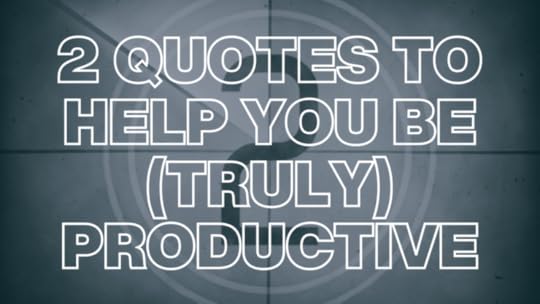
Yep. It’s an ugly title. But I wanted to make sure that you offer up some attention to the following 2 quotes. You can do that in whatever order you choose:
“To be yourself in a world that is constantly trying to make you something else is the greatest accomplishment.”
Ralph Waldo Emerson
“Between stimulus and response, there is a space. In that space is our power to choose our response.”
Viktor Frankl
Take both of these 2 quotes. Think on them simultaneously. It will help you live up to both of them… and be the best version of yourself at any given moment.
Think About The 2 QuotesIf you take a moment when dealing with anything that comes at you over the course of the day (aka stimulus) and use that space between it showing up and how you deal with it to do your best to be yourself in that space, you’ll be all the better for it. (Go back and read that sentence again. It’s a bit of a thinker.)
You will find yourself doing for the sake of doing less often. You’ll have less regret over choices you make. You’ll be more aware of the consequences of those choices.
Best of all, you’ll be giving your greatest intention – being yourself – the attention it truly deserves.
John Cleese says you need two things to be creative: time and space. I think it goes beyond that. You need time and space to make better decisions. Time and space will help you to take right action.
You need time and space to be yourself.
Keep these 2 quotes from Emerson and Frankl (or Frankl and Emerson) close at hand until they become fully integrated into your life. Use them as waypoints for your decisions.
Do that and you’ll be in a far better position to stop doing productive and start being productive.
The post 2 Quotes That Will Help You Be (Truly) Productive appeared first on Productivityist.

January 19, 2022
Episode 406: Perrine Farque talks about Inclusion

I’m glad I’m not the only one that enjoys a cup of coffee in the late afternoon.
When I spoke with my guest on this episode, I was politely surprised that her drink of choice during our discussion was her 4:30 PM tasse de café.
Perrine Farque and I had a conversation that revolved largely around her area of expertise: inclusion. That’s also the title of her book, which came up quite a bit during our chat… and for good reason. You see, within its pages lies the ultimate secret for an organization’s success.
Perrine is an author, entrepreneur, keynote speaker and diversity expert who empowers leaders to leverage diversity as their competitive advantage. Nominated in the Top 50 Most Influential UK Tech Women, Perrine continues to be recognized for her contributions.
It’s been said that you tend to learn what you don’t want to see in an organization from working for one, and that seems to be how Perrine started down her path as an inclusivity expert. She shares that story with me – her starting point in both her journey and the book.
We get into acronyms (we’re both fans of them) and Perrine explores one of them with me in greater depth. Other things we get into include a way to think of yourself than can help promote inclusivity, the ever-present problem of “impostor syndrome”, and how to break through beliefs that integrating an inclusive culture into the workspace isn’t as overwhelming as some make it out to be.
(I even mention taking inclusivity to the idea of making sure night owls feel heard just as much as early risers do in the workplace. SPOILER ALERT: Perrine agrees.)
Perrine drove the strategy at companies such as Facebook and is on a mission to make the workplace more inclusive and diverse. After listening to this conversation, I think you’ll see that she is well on her way to accomplishing that mission.
Want to support the show? Then take a look at our podcast sponsors page.
There you will find a variety of products and services designed to help you lead a more productive life.
Want to support the podcast? Beyond checking out our sponsors, you can subscribe to the show wherever you listen to podcasts. Click on any of the links below to make that happen.
Spotify | Apple Podcasts | Google Podcasts | Stitcher
You can also click on this link to paste the podcast feed into your podcast app of choice.
Thanks again for listening to A Productive Conversation. See you later.
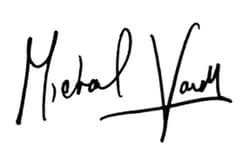
The post Episode 406: Perrine Farque talks about Inclusion appeared first on Productivityist.

January 17, 2022
How to Start Pacing Your Productivity
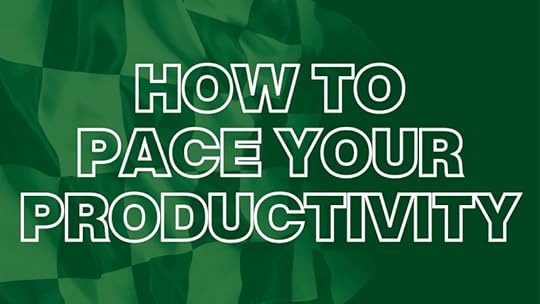
When contemplating your level of productivity, it’s easy to get caught up in how much you’re able to do in a given day, week, and so on. Quantified productivity is something anyone can calculate. It’s why measurements like Inbox Zero have become so popular in figuring out whether or not you have had a productive day.
The problem with using numbers to constantly measure productivity – especially personal productivity – is that they don’t always paint an accurate picture. Sure, they’ll tell you how much of something you’ve finished, but they won’t necessarily tell you whether or not those were the right things to do.
That’s where the nuance of qualitative productivity comes into play.
Qualitative productivity is geared around the idea that what you’ve been productive with is of a higher quality. Essentially, you might wind up doing far less tasks but the impact they have over the long term is greater than what quantitative productivity can achieve. Getting to Inbox Zero every day might feel great more often but if you aren’t doing the things that are more impactful then you’re not seeing (or measuring) the entire landscape of your tasks through to completion.
I’m not suggesting that you should abandon quantitative productivity altogether. It’s an important measurement. But it shouldn’t be the only – or even primary – way we determine how productive we’ve been. What you need is a healthy balance of quantitative and qualitative productivity.
And that’s when you must consider pacing your productivity. It’s how you’ll be able to more accurately measure your productivity.
Pacing your productivity can come in several forms.
Pacing by PriorityDo you know what can happen when you are focused on getting as much as you can done in a day? You can lose sight of what the most important tasks are that you should be focusing on.
That’s when you wind up with a false sense of how productive you were for the day; you did plenty of things but not the most important thing.
When you pace your productivity by priority you’ll make progress on what you prioritize. That means you’ll do the most important thing no matter how long it takes – perhaps even breaking it down into smaller things that can be done to further your progress.
The end result of pacing your productivity this way is that you may not end up with as many tasks checked off your to-do list but the ones that matter the most will be. Plus you’ll start to measure your productivity in a more balanced way.
Pacing by EnergyIncidentally, when you pace by priority that doesn’t mean you’ll do that thing first off. If you’re like me, you’ll wait until your energy is best suited to work on that priority.
When you pace your productivity by energy, you’ll tackle your to-do’s based on your body clock.
If you’re someone who is an early riser (or a Lion, as outlined in The Power of When) then you’d be best serving yourself and your to-do list by taking on your most energy-sensitive tasks early in the day. Then tackle the ones that don’t need the best of you as the day draws to a close.
If you’re like me, you’ll work the other way. I’m a night owl (or a Wolf). So I start my day with lower energy tasks and then hit the high energy tasks starting in the afternoon. I’m actually writing this blog post at 3 PM, during the Horizontal Theme of 2-6 PM. This themed timeframe is what I’ve set aside every weekday for Writing.
So instead of working through your daily tasks in a sequential or ranked order of priority, try pacing your productivity the way your body clock works. You’ll be able to bring the ideal amount of energy, attention, and effort to each task if you do.
Pacing by LimitationThere’s only so much you can do in a day. We often overestimate that number. When we estimate what we’ll be able to in a day and fall short of that number, it isn’t just our perception of our productivity that takes a hit. It can affect our overall well-being.
Jesse Itzler circumvents this by avoiding the whole “X number in a day” concept. He broadens the scope to a week instead.
You can do the same. Maybe you should.
Instead of getting to Inbox Zero every day, strive for it every week. (If Inbox Zero is your thing, that is.) Rather than write 1000 words per day, shoot for 5000 a week. Miss a day and you can make up for it on other days.
There will be tasks that you will want to do on certain days. Give those tasks room to breathe. Don’t overload yourself with other tasks that you don’t need or want to do on those days.
Limitations are important. Setting limits that are reasoned makes sense, so set some for yourself on a daily, weekly, and monthly basis. When you go beyond those limits, you can stretch them in the future. You’ll find that sweet spot at some point… and that spot may differ depending on the day, week, or month.
If you’re open to exploring this way of pacing your productivity, then I invite you to start with a limit that I think works well. It’s a number that allows you to give attention to your intentions without casting aside the demands of others in the process. (In other words, both you and those that are affected by what you do will recognize how productive you are.
The number is 6.
And if you’d like to explore the power of this number, then check out my productivity program, The Six, here. We’re human beings, not human doings. Pacing your productivity will help you live up to that. Just because technology allows for things to happen faster than ever doesn’t mean that everything can (or should) happen at that breakneck speed. There’s a reason the term “breakneck speed” exists, after all.
Try any (or all) of the above ways to pace your productivity and I know you’ll feel more like you’re not “doing” productive. You’ll feel – and know – that you’re being productive.
The post How to Start Pacing Your Productivity appeared first on Productivityist.

January 12, 2022
Episode 405: Becca Ribbing talks about Clarity, Getting Unstuck, and Journaling
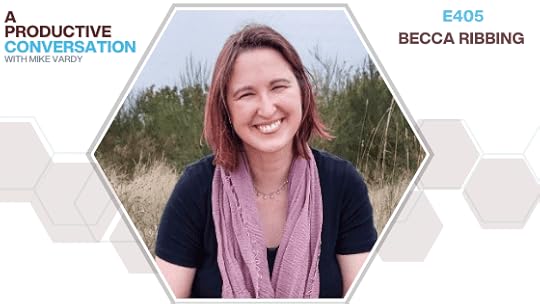
Not too long ago, I changed the way we introduce each episode of the podcast. If you’ve been listening for a while, then you probably know what that charge was. But it wasn’t as if I just abruptly decided to make that change. I gave it a lot of thought.
Becca Ribbing knows a thing of two about giving things thought.
She’s the author of The Clarity Journal, so clarity is something she givers a lot of attention to. The change to the way I kick off each episode was the result of me getting clear about what I wanted to achieve at the start of the show, so I wanted to talk with Becca about the importance of clarity and mindful productivity.
She learned meditation at a young age – I mean really quite young – and she shares her experience with meditation during our discussion. It’s definitely played a factor in how she approaches things – including meditation itself.
In fact, her mention of “noticing” harkens back to a conversation I had with Rob Walker on this podcast – before the changes to the introduction were made.
Although we spend time discussing this simple and small change to the beginning of my podcast episodes, we do go well beyond that during our conversation. I believe the bridge to the rest of our conversation started off when she said this:
“When people area ready to jump to a new level, they don’t always take stock of everything that’s going into it.”
And this is where Becca believes The Clarity Journal can help.
It can help when you’re stuck. It can help when you are aware you need a change but aren’t sure what the next step – or steps – are. (It’s also worth noting that you may not even know what that change is yet!)
Becca goes into how she came up with the concept for The Clarity Journal, the thing that a friend told her that she absolutely needed to hear, and she reveals whether or not she was someone who journaled elsewhere before she created her own journal.
I hope you enjoy this conversation. It’s been in the works for a while and I’m glad I can deliver it to you now.
Want to support the show? Then take a look at our podcast sponsors page.
There you will find a variety of products and services designed to help you lead a more productive life.
Want to support the podcast? Beyond checking out our sponsors, you can subscribe to the show wherever you listen to podcasts. Click on any of the links below to make that happen.
Spotify | Apple Podcasts | Google Podcasts | Stitcher
You can also click on this link to paste the podcast feed into your podcast app of choice.
Thanks again for listening to A Productive Conversation. See you later.

The post Episode 405: Becca Ribbing talks about Clarity, Getting Unstuck, and Journaling appeared first on Productivityist.

January 10, 2022
6 Personal Factors That Impact Productivity
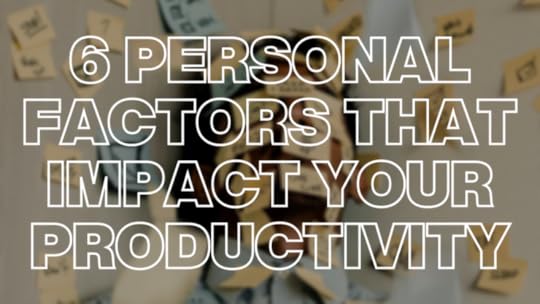
Most of the things that impact productivity exist in the office. However, how well you’re able to work isn’t only impacted by office setup or the apps you have. Your personal life can also have an influence on your productivity.
Though plenty of people say that you should try to keep your professional and personal lives separate, that’s not always possible. What we do outside of the office can impact what happens inside of it.
Here are 6 key things that impact productivity… and some tips on how to overcome them.
Sleep IssuesWhether you’re a morning person or a night owl, you can’t expect to work well if you’re running off just a few hours of sleep.
If you’re going to deliver your best work, then you’ll need to be fully refreshed and energized. If you find that you’re spending too much of your time tossing and turning, then make some changes.
For example, studies have shown that limiting the amount of screen time before hitting the hay is useful. So is drinking a relaxing cup of tea (which I do before bed) and meditating (which I’ve started to do before going to bed).
Also… take another look at your bedroom: is it as conducive to sleep as it could be?
How You Start The DayYou won’t be productive if you’re spending the first couple of hours at the office just trying to wake your mind up.
In an ideal world, you’d get started with work you’ve mapped out for the day the moment that you walk through the office door. That won’t be possible if you’re rushing around and getting to the office without a plan of action for the day.
So either plan tomorrow the day before or wake up a little earlier than you usually would. Doing either of these things – or both – will give you time to read, eat a healthy breakfast, and just enjoy the morning. Then you’ll find that you’re ready for action when you hit the office.
Social VicesIf you want to work well when you’re at the office, then you’ll need to have a greater command of your life outside of it. Being social to a point is fine – and is essential for your well-being. It’s when things get off the rails that the tides can turn on you and your productivity.
Drinking too much alcohol is where this can really take hold. Doing this will make it impossible to work productively – it’s not easy to work with a hangover. While this can happen, if it’s becoming more frequent then you need to take action. It’ll be essential to cut down. You can use some addiction resources if you find it difficult to stop… or if you think you have a problem.
Even if you don’t have a problem with alcohol, it can be beneficial to drink less often – or even stop altogether. As much as I like to have a good beer or cocktail, I keep that kind of socializing at more of a minimum these days. Doing that has helped me give more focused attention to my intentions better than before.
Personal ProblemsMany of us have gone through some personal issues in the past couple of years – myself included. And though we might be nearing the end of the pandemic, it’s not as if problems won’t pop up from time to time. They’re just a part of life.
And they can really begin to impact productivity in your professional life unless you take steps to prevent that from happening. If possible, you should try to put problems aside as best you can when you walk through the office door. Do that even if that office door is just down the hall from your bedroom.
If you can’t do that and find you’re overwhelmed by these personal problems, then try to take some time off work. It’ll be better to spend a week giving dedicated attention to these problems rather than trying to juggle everything personal and professional all at once.
Your HomeSome people were already working from home when the pandemic hit. (I’ve been working from home for over a decade now.) But once we were in the throes of the pandemic, far more people were working from home than ever before.
While it can be nice to work from the comfort of our own home, there can be issues with productivity. This is because our homes generally aren’t set up for work.
If you have to work from your house, then try to create a space that will help you to work well. You might be tempted to work from your bedroom, but steer clear of that. Trust me on that; I speak from experience. Instead, set aside a small space in your home away from the bedroom. That’s what you really need to do.
Mental StateAs well as your physical well-being, it’s important to focus on your mental health.
If your mental health isn’t as on point as it could be, then your work will suffer. For example, you might find it hard to focus. Or you’ll feel drained of energy earlier in the day than you should.
There are plenty of ways to improve your mental health. Meditation, working out, eating well, and spending more time in the great outdoors are great places to start.
And that’s where I’ll end things with you. While you can try to tackle more than one of theses areas that impact productivity… don’t. I encourage you to start with one and expand from there. The last thing you want to do is overwhelm yourself along the way to more productive days, weeks, months, and beyond.
The post 6 Personal Factors That Impact Productivity appeared first on Productivityist.

January 5, 2022
Episode 404: Stacy Tuschl talks about The Implementation Code
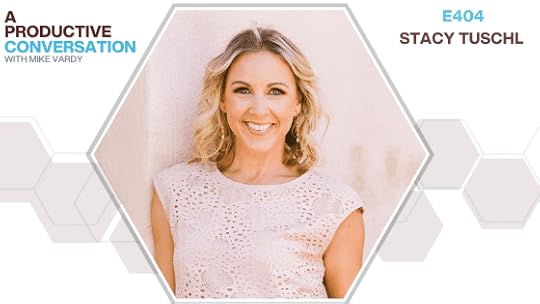
Productivity makes Stacy Tuschl tick.
As I went through her new book, I found myself “dog-earing” it relentlessly. The book is titled The Implementation Code: Unlocking The Secret To Getting It All Done and when I was able to secure another conversation with Stacy – she’s been on he podcast before as you’ll see in the show notes – I knew we’d have plenty to discuss.
In addition to being a Small Business Growth Coach, Stacy is a bestselling author, and founder
of the Foot Traffic Formula – helping small businesses around the world get more customers in the door, more profit in their pocket and more happiness in their homes. Stacy’s started a bunch of prosperous ventures – including turning a company she started in her parents’ backyard at the age of 18 into a multi-million dollar enterprise that she still runs today.
Stacy and I talk about the things people don’t want to do but that we all need to do. Then we discuss the importance of maintenance, as illustrated in these words from Stacy:
“Without maintenance things have a way of reverting to the previous state.”
(And she explains what maintenance isn’t about during our discussion as well.)
As I went through Stacy’s book, I took notice of how vulnerable she was willing to be in her writing. That comes across in the words she’s written and the words she shares in this episode.
There was a lot of back and forth during this episode – so much more than I can put into words here. So take 40 minutes and give our words a listen. (Especially Stacy’s.)
I hope you enjoy this conversation… and take away some things that you can implement today.
Want to support the show? Then take a look at our podcast sponsors page.
There you will find a variety of products and services designed to help you lead a more productive life.
Want to support the podcast? Beyond checking out our sponsors, you can subscribe to the show wherever you listen to podcasts. Click on any of the links below to make that happen.
Spotify | Apple Podcasts | Google Podcasts | Stitcher
You can also click on this link to paste the podcast feed into your podcast app of choice.
Thanks again for listening to A Productive Conversation. See you later.

The post Episode 404: Stacy Tuschl talks about The Implementation Code appeared first on Productivityist.

January 3, 2022
How to Dog-Ear a Book

When someone dog-ears a book, they fold the corner of a page so that they can keep track of their progress. They think of it as a bookmark.
I don’t. I actually use a bookmark to mark my place in a book. Dog-earing is something I use differently. I use it to mark places where I discovered takeaways. These are things I’d like to track and make note of for future reference.
During one of my conversations on my podcast (link here), I revealed how I know where to look in books for specific things (like notes and quotes). It involves dog-earing the book in two different ways.
The first way is pretty common. I use the top corner of a page to let me know that I’ve made a note on that page that I’d like to use for reference. Maybe it’s for a podcast conversation or maybe it’s for research for something I’m writing. But by folding the upper corner of a page I know that is what I’ll find on that page.
The second way is what I use if I have quotations I’d like to cite in my writing or bring up in a conversation with a guest on the show. Those dog-eared corners are made on the lower corners of pages instead.
It’s a simple method that does the job… as most simple methods do.
I do mark up my books with pen so they show up on those dog-eared pages as well. The markings make what I’m looking for easy to find.
If you are not interested in making a book look well-worn (and well-read) then don’t follow my lead. But if you want to make the most of your paper book reading experience —especially if you are reading for research— then I encourage you to give this way I dog-ear a try.
This trick has worked for me for years. I think it can do the same for you.
The post How to Dog-Ear a Book appeared first on Productivityist.

December 29, 2021
Episode 403: John Meese talks about Profit, Growth and Thriving
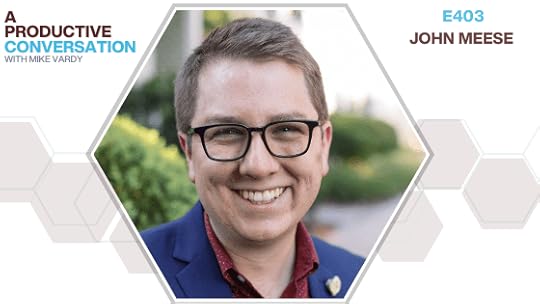
Find out how to move from survival to thriving with your business with economist-turned-entrepreneur John Meese.
John is on a personal mission to eradicate generational poverty by helping entrepreneurs create thriving businesses which is why he wrote ‘Survive and Thrive: How to Build a Profitable Business in Any Economy (Including This One)’. John is CEO of Cowork.Inc, Co-founder of Notable, and host of the Thrive School podcast.
It was great having John back on the show to discuss his latest book. We discussed how to embrace problems, strategies of growing a business, being around like-minded people, and the power of coworking spaces.
Want to support A Productive Conversation with Mike Vardy? Then take a look at our podcast sponsors page where you can find a variety of products and services designed to help you lead a more productive life. You can see all of our current sponsors – including the ones for this episode – here.
Talking PointsHis process of writing the book The profit-first mindsetThe theme of service throughout his researchThe five ways of growing a businessHaving the right people around youJohn’s coworking spaceMoving from the survival to the thriving state of your businessHelpful LinksEpisode 336: Visibility Bias with John MeeseEpisode 239: Free to Focus with Michael HyattEpisode 289: The Vision Driven Leader with Michael HyattEpisode 388: Mike Michalowicz talks about Getting DifferentHow WeWork Became WeBroke – John MeeseGet Your ThriveScoreSurviveAndThriveBook.comJohn Meese’s LinkedInThrive School with John Meese“As an entrepreneur, the world is counting on you to solve problems.“
– John Meese
Enjoy the show? Want to keep up with the podcast? You can subscribe to the podcast feed by clicking the “Share” button in the player above – and you can share it further using the same button as well. You can take things even one step further by rating and reviewing the show wherever you listen to podcasts. (FYI: I use Overcast on iOS.)
The post Episode 403: John Meese talks about Profit, Growth and Thriving appeared first on Productivityist.

December 22, 2021
Episode 402: Wes Kao talks about Maven, Cohort-based Learning and Seth Godin

As co-founder of the altMBA, Wes Kao helped create the modern cohort-based education movement with Seth Godin.
Wes has led over 150 launches for Fortune 500 brands and startups, and is recognized as a leading expert in B2C marketing. Now she’s taking the category she helped create to the next level with her new startup Maven, the world’s first digital platform for cohort-based courses.
I learned heaps from this conversation as Wes unpacked all things cohort-based learning. Tune in to find out more about creating an engaging course, how the best courses evolve, growing your community, and the power of beta-testing.
Want to support A Productive Conversation with Mike Vardy? Then take a look at our podcast sponsors page where you can find a variety of products and services designed to help you lead a more productive life. You can see all of our current sponsors – including the ones for this episode – here.
Talking PointsThe rising trend of learning cohortsSome common mistakes made by first-time course creatorsWhy it’s never too late to start a cohort-based learning courseThe impact of people working from homeHow to make the most out of online learningRepurposing evergreen content into cohort-based courseHelpful LinksAltMBAEpisode 343: Consistency Over Authenticity with Seth GodinWes Kao’s websiteWes Kao’s TwitterMaven’s TwitterMaven“The less tools you have, the less things will break.“
– Wes Kao
Enjoy the show? Want to keep up with the podcast? You can subscribe to the podcast feed by clicking the “Share” button in the player above – and you can share it further using the same button as well. You can take things even one step further by rating and reviewing the show wherever you listen to podcasts. (FYI: I use Overcast on iOS.)
The post Episode 402: Wes Kao talks about Maven, Cohort-based Learning and Seth Godin appeared first on Productivityist.
[image error]December 15, 2021
Episode 401: Dr. Michael Breus talks about Energy Management, Movement and Sleep
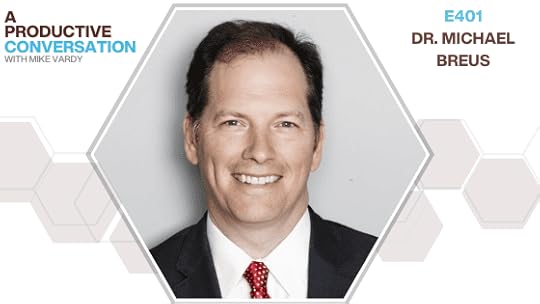
Learn how to sleep well and manage your energy throughout the day with world-renowned sleep expert Dr. Michael Breus.
Dr. Michael Breus, Ph.D., is a Clinical Psychologist and both a Diplomate of the American Board of Sleep Medicine and a Fellow of The American Academy of Sleep Medicine. He is one of only 168 psychologists in the world to have passed the Sleep Medical Speciality board without going to Medical School. Dr. Michael Breus was recently named the Top Sleep Specialist in California by Reader’s Digest, and one of the 10 most influential people in sleep.
Michael is also ‘The Power of When’, ‘The Sleep Doctor’s Diet Plan: Lose Weight Through Better Sleep’ and ‘GOOD NIGHT: The Sleep Doctor’s 4-Week Program to Better Sleep and Better Health’. In this episode, we explore his most recent book, co-authored with Stacey Griffith, ‘Energize!: Go from Dragging Ass to Kicking It in 30 Days’.
Tune in also to learn more about energy management techniques, knowing your body type, morning stretches, his unbelievably simple sleep program – and being a wolf.
Want to support A Productive Conversation with Mike Vardy? Then take a look at our podcast sponsors page where you can find a variety of products and services designed to help you lead a more productive life. You can see all of our current sponsors – including the ones for this episode – here.
Talking PointsHow your body type and type of exercise affects your sleepLearn how to manage your energy levelsBeing a ‘fast wolf’The correlation between melatonin production and ageLearning from how animals wake upEmotional energizers and vampiresIdentifying your definition of energyHelpful LinksThe Power of When with Dr Michael BreusEnergizeMyself.comTheSleepDoctor.comChronoQuiz.comDr Michael Breus’ TikTok“I focus more on energy management, not time.“
– Dr. Michael Breus
Enjoy the show? Want to keep up with the podcast? You can subscribe to the podcast feed by clicking the “Share” button in the player above – and you can share it further using the same button as well. You can take things even one step further by rating and reviewing the show wherever you listen to podcasts. (FYI: I use Overcast on iOS.)
The post Episode 401: Dr. Michael Breus talks about Energy Management, Movement and Sleep appeared first on Productivityist.




